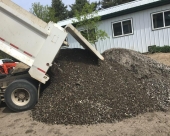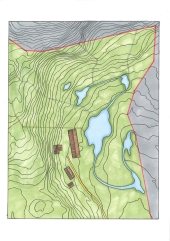
 1
1




 1
1




Joy to You
 4
4





 3
3




Some places need to be wild
 1
1




Invasive plants are Earth's way of insisting we notice her medicines. Stephen Herrod Buhner
Everyone learns what works by learning what doesn't work. Stephen Herrod Buhner
 1
1





 Just to be clear, I am joking. The land plane does certainly have its place, but for us, we have a good, flat surface which drains well and has features to prevent water running at high velocity. Our main issue is surface erosion due to water droplets striking the soil and carrying the dirt away; we are more at the "rill" stage than the "gulley" stage. We need some type of surface covering that is resilient to surface motivation by heavy rain, and gravel is just not achievable for us.
Just to be clear, I am joking. The land plane does certainly have its place, but for us, we have a good, flat surface which drains well and has features to prevent water running at high velocity. Our main issue is surface erosion due to water droplets striking the soil and carrying the dirt away; we are more at the "rill" stage than the "gulley" stage. We need some type of surface covering that is resilient to surface motivation by heavy rain, and gravel is just not achievable for us.
 1
1














 1
1




Some places need to be wild
 2
2




Sam said, " The problem is we just can't afford to get it here. This is really rough country up here, and finding someone who will even agree to deliver is rare. The prices are just too high, considering that our subgrade is already resilient to driving on.
Invasive plants are Earth's way of insisting we notice her medicines. Stephen Herrod Buhner
Everyone learns what works by learning what doesn't work. Stephen Herrod Buhner
 3
3




SKIP books, get 'em while they're hot!!! Skills to Inherit Property
See me in a movie building a massive wood staircase:Low Tech Lab Movie
 1
1




 1
1




I think ground cover to limit washaway is a great idea. If I were you I would take a look next time I went "to town" and see what is growing in idle areas (parking lot borders, vacant spaces) and also what is being put down when earthworks are done (you might be able to call up your local dept of public works and ask). I think there are two routes- either natives that suit your land and you can just let run, (maybe some of the things here https://choosenatives.org/articles/plant-native-ground-covers-make-america-green/ , see the links at the bottom) or, alternatively, things you can get bags of seed for and get in the ground quickly. Maybe local extension might be a good place to ask as well.
Visit Redhawk's soil series: https://permies.com/wiki/redhawk-soil
How permies.com works: https://permies.com/wiki/34193/permies-works-links-threads
 1
1





 If the selected grass type did tend to grow too tall, I would have no issue with a little upkeep from time to time. I agree with you that tall grass is better!
If the selected grass type did tend to grow too tall, I would have no issue with a little upkeep from time to time. I agree with you that tall grass is better!
 1
1




Is this an excuse to own a pair of cows? And a little electric fence?Sam Willis wrote:
I'd personally be ok with never mowing itIf the selected grass type did tend to grow too tall, I would have no issue with a little upkeep from time to time. I agree with you that tall grass is better!
That would be an interesting experiment - please report back on the results. Permies have long memories, and I for one, really like hearing the "5 year report" - I'm in this for the long run!One thought I've had over the past couple days is to purchase washed rock about 3/4" size, and scatter it as thinly as possible. Since our subgrade is very firm in the majority of the road, this should press into the surface and prevent both running water erosion and rain drop strike erosion. I might try this in a small section and see how it goes. This should make a given quantity of rock go a lot further!
Visit Redhawk's soil series: https://permies.com/wiki/redhawk-soil
How permies.com works: https://permies.com/wiki/34193/permies-works-links-threads
 3
3




John Daley Bendigo, Australia The Enemy of progress is the hope of a perfect plan
Benefits of rainfall collection https://permies.com/t/88043/benefits-rainfall-collection
GOOD DEBT/ BAD DEBT https://permies.com/t/179218/mortgages-good-debt-bad-debt
 1
1




John Daley Bendigo, Australia The Enemy of progress is the hope of a perfect plan
Benefits of rainfall collection https://permies.com/t/88043/benefits-rainfall-collection
GOOD DEBT/ BAD DEBT https://permies.com/t/179218/mortgages-good-debt-bad-debt
















 3
3




Some places need to be wild
 1
1




John Daley Bendigo, Australia The Enemy of progress is the hope of a perfect plan
Benefits of rainfall collection https://permies.com/t/88043/benefits-rainfall-collection
GOOD DEBT/ BAD DEBT https://permies.com/t/179218/mortgages-good-debt-bad-debt

|
30 seconds to difuse a loaf of bread ... here, use this tiny ad:
The new permaculture playing cards kickstarter is now live!
https://www.kickstarter.com/projects/paulwheaton/garden-cards
|




